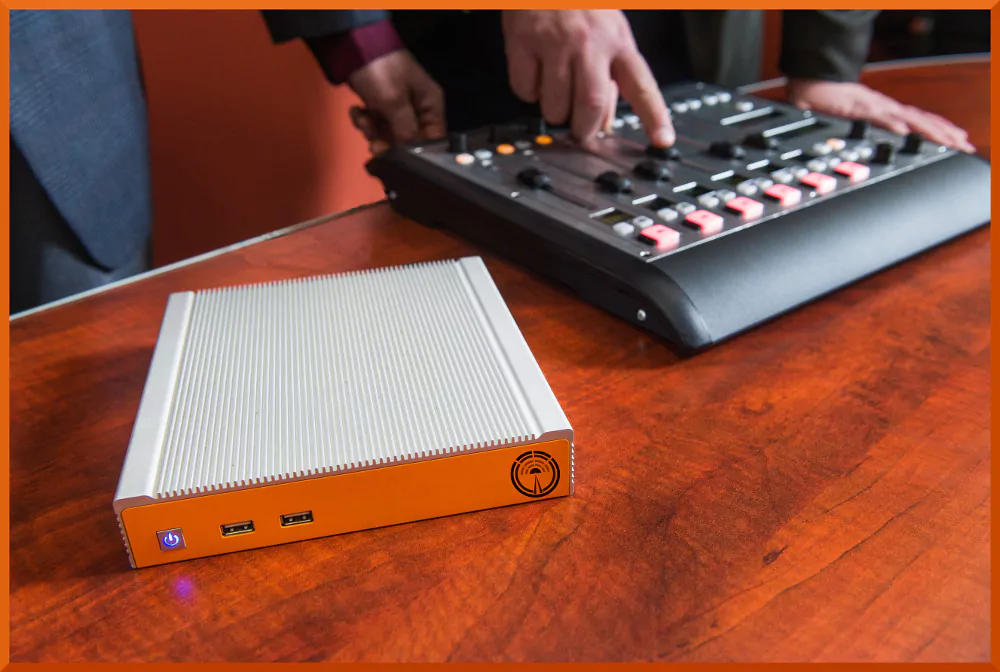AoIP (Audio over IP) is an umbrella term for various technologies that allow for music to be transmitted over IP networks and the Internet. It is used for a variety of applications such as broadcasting, video production and audio recording. AoIP uses internet protocols to reduce cost and complexity of audio systems compared to traditional analog systems, and makes it possible to send audio over long distances. AoIP also enables the use of distributed audio systems where audio signals are split into multiple parts and sent over different locations, allowing for a more efficient use of resources. AoIP technology is based on several standards such as Livewire, RTP and Ravenna. Livewire is an audio over Ethernet protocol developed by Axia, which allows for up to 32,767 channels to be transmitted over Ethernet. RTP (Real–time Transport Protocol) is an internet protocol used for streaming audio and video over IP networks. Ravenna is a digital audio over IP protocol developed by AES67, which allows for interoperability between dissimilar devices from various manufactures. AoIP is used by broadcasters, audio professionals and video producers to reduce the cost and complexity of audio systems compared to traditional analog systems. AoIP makes it possible to send audio over long distances on regular TCP/IP networks.
Livewire RTP
Livewire routing capabilities enable easy reconfiguration of patch bays and signal sources High quality RTP streaming audio with low latency over the network Integrated RTP audio streams can be routed between Axia digital consoles, Ravenna/AES67 devices and RTSP servers Livewire AES67/Ravenna devices provide audio streaming and routing between systems
Each OBPlayer audio over Ethernet channel sends out a multicast RTP (Real-time Transport Protocol) stream that appears as a channel on Axia AoIP digital consoles. The outgoing digital stream from the console station is ingested into our systems, then sent to an Icecast server, where a BARIX unit at the transmitter site plays out on radio. This means the stream is 100% digital from OBPlayer to digital console, up through STL (Studio Transmitter Link) to the BARIX exstreamer at the transmitter site, RTP audio in and out of the Livewire xNode devices with Livewire QOR16\xNode devices connected to our RTSP server, now integrated into OBPlayer.
- Solid state fan less infrastructure reduces station clutter, AC power loads and hardware failures
- Web friendly 100% digital audio on a quality Axia platform provides a cleaner signal path
- Additional studios and equipment are easily integrated with Livewire, RTP and Ravenna protocols
- Livewire routing capabilities enable easy reconfiguration of patch bays and signal sources
- High quality RTP streaming audio with low latency over the network
- Integrated RTP audio streams can be routed between Axia digital consoles, Ravenna/AES67 devices and RTSP servers
- Livewire AES67/Ravenna devices provide audio streaming and routing between systems
Ravenna
Ravenna is a protocol that enables interoperability between dissimilar devices from various manufacturers, allowing all of them to communicate, send and receive audio over Ethernet, and make digital audio available over standard networking. It is becoming increasingly popular as it allows for more efficient and cost effective streaming solutions for audio over IP.
AES67 is backward-compatible with the Ravenna audio over Ethernet protocol, so future digital consoles,devices and equipment will continue to inter operate in the digital world. We will not have the SIP implementation that AES67 requires, until we find a Gstreamer library that implements SIP.
In OBPlayer’s streaming tab, there are settings to configure an RTSP server in the player, which the xNode and digital engines connect, in order to receive our audio over Ethernet output. It works similarly to the Icecast streamer, receiving audio from Pulse/JACK and not directly from the player’s output, allowing the audio to be mixed and changed before the final output is sent, including a means of advertising the RTSP server as a Ravenna session on the network, with the Streaming tab providing a setting for RTP output. This can be configured with the multicast address 239.192.0.x, where x is the Livewire port number. OpenBroadcaster RTSP server appears to the Axia xNode as a Ravenna RTP.
EAS Emergency CAP Alerts
EAS Emergency CAP Alerts can be easily injected into AoIP digital consoles using built–in GPIO relays, allowing users to switch channels and activate warning lights. Audio from the CAP Emergency alert messages can be streamed on demand to an Icecast media server, providing multi–channel management of status, transponding of player out, and streaming on demand. There are an estimated 7,000 AoIP digital consoles and 70,000 networked audio devices available for connection to this system, making it an efficient and effective way to deliver critical information.
We offer affordable custom scalable Enterprise Broadcasting solutions designed to meet your community radio and television needs. Subscribe to our Newsletter to stay up–to–date with the latest news and developments in the world of broadcasting. Our team of experts is ready to help you with your project. Moreover, we invite you to Sponsor and Contribute to open source broadcasting projects. To learn more about our services Contact us today how we can help you to get started now!
![]()

